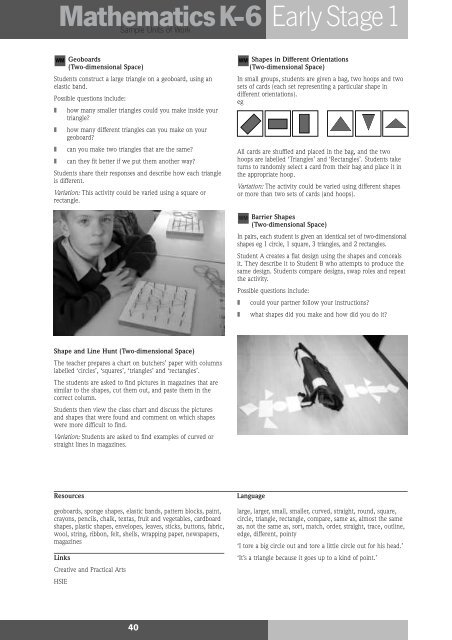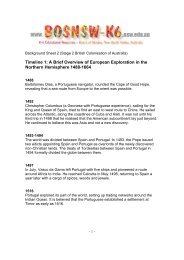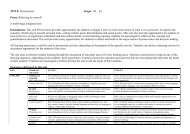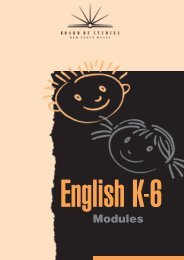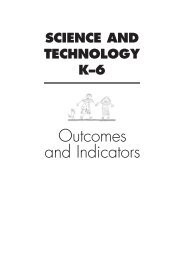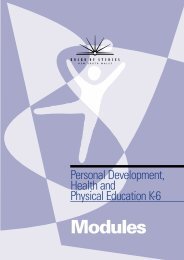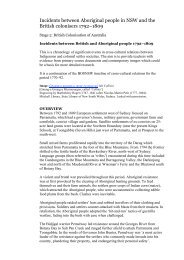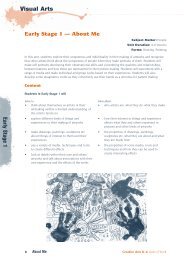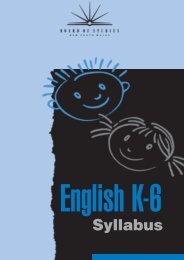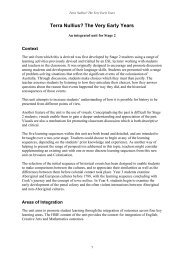Math K-6 WS - K-6 Educational Resources
Math K-6 WS - K-6 Educational Resources
Math K-6 WS - K-6 Educational Resources
You also want an ePaper? Increase the reach of your titles
YUMPU automatically turns print PDFs into web optimized ePapers that Google loves.
<strong>Math</strong>ematicsK-6 Early Stage1<br />
WM<br />
Geoboards<br />
(Two-dimensional Space)<br />
Students construct a large triangle on a geoboard, using an<br />
elastic band.<br />
Possible questions include:<br />
❚ how many smaller triangles could you make inside your<br />
triangle?<br />
❚ how many different triangles can you make on your<br />
geoboard?<br />
❚ can you make two triangles that are the same?<br />
❚ can they fit better if we put them another way?<br />
Students share their responses and describe how each triangle<br />
is different.<br />
Variation: This activity could be varied using a square or<br />
rectangle.<br />
Shape and Line Hunt (Two-dimensional Space)<br />
The teacher prepares a chart on butchers’ paper with columns<br />
labelled ‘circles’, ‘squares’, ‘triangles’ and ‘rectangles’.<br />
The students are asked to find pictures in magazines that are<br />
similar to the shapes, cut them out, and paste them in the<br />
correct column.<br />
Students then view the class chart and discuss the pictures<br />
and shapes that were found and comment on which shapes<br />
were more difficult to find.<br />
Variation: Students are asked to find examples of curved or<br />
straight lines in magazines.<br />
geoboards, sponge shapes, elastic bands, pattern blocks, paint,<br />
crayons, pencils, chalk, textas, fruit and vegetables, cardboard<br />
shapes, plastic shapes, envelopes, leaves, sticks, buttons, fabric,<br />
wool, string, ribbon, felt, shells, wrapping paper, newspapers,<br />
magazines<br />
Links<br />
Creative and Practical Arts<br />
HSIE<br />
Sample Units of Work<br />
<strong>Resources</strong> Language<br />
40<br />
WM Shapes in Different Orientations<br />
(Two-dimensional Space)<br />
In small groups, students are given a bag, two hoops and two<br />
sets of cards (each set representing a particular shape in<br />
different orientations).<br />
eg<br />
All cards are shuffled and placed in the bag, and the two<br />
hoops are labelled ‘Triangles’ and ‘Rectangles’. Students take<br />
turns to randomly select a card from their bag and place it in<br />
the appropriate hoop.<br />
Variation: The activity could be varied using different shapes<br />
or more than two sets of cards (and hoops).<br />
WM<br />
Barrier Shapes<br />
(Two-dimensional Space)<br />
In pairs, each student is given an identical set of two-dimensional<br />
shapes eg 1 circle, 1 square, 3 triangles, and 2 rectangles.<br />
Student A creates a flat design using the shapes and conceals<br />
it. They describe it to Student B who attempts to produce the<br />
same design. Students compare designs, swap roles and repeat<br />
the activity.<br />
Possible questions include:<br />
❚ could your partner follow your instructions?<br />
❚ what shapes did you make and how did you do it?<br />
large, larger, small, smaller, curved, straight, round, square,<br />
circle, triangle, rectangle, compare, same as, almost the same<br />
as, not the same as, sort, match, order, straight, trace, outline,<br />
edge, different, pointy<br />
‘I tore a big circle out and tore a little circle out for his head.’<br />
‘It’s a triangle because it goes up to a kind of point.’


